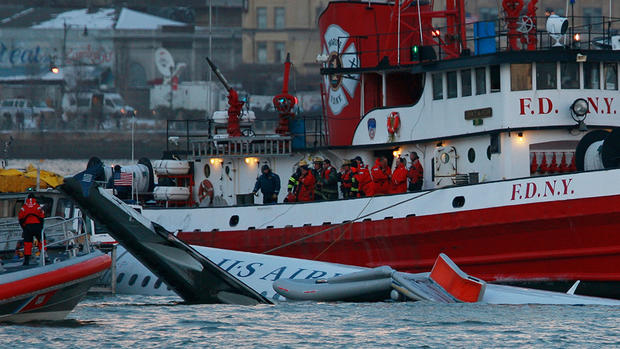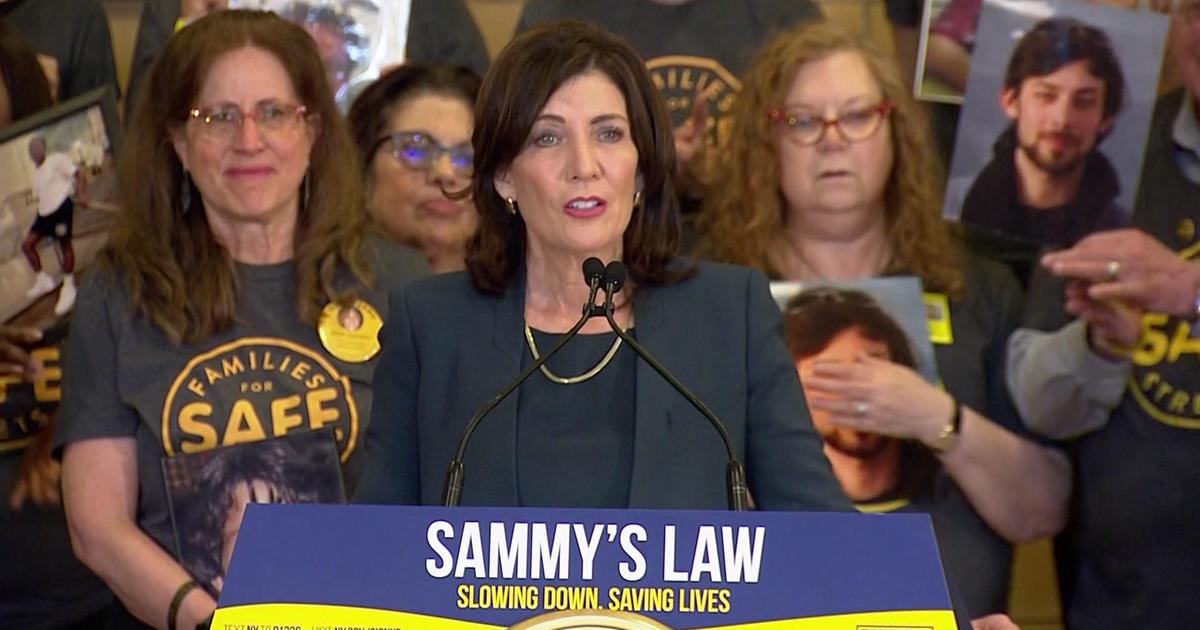NYC Marks 10 Years Since Flight 1549's 'Miracle On The Hudson'
LOOKING BACK, AT-A-GLANCE
- Photo Gallery: 'Miracle On The Hudson:' Then To Now
- First Reporter On Scene Of 'Miracle On The Hudson' Flight: 'It Was Amazing'
- Original Report From WCBSTV.com On Jan. 15, 2009.
- Watch: Archive Video Of CBS2 News Coverage Of US Airways Flight 1549
NEW YORK (CBSNewYork) -- Tuesday marks one decade since Capt. Chesley B. "Sully" Sullenberger and the crew of US Airways Flight 1549 turned what could have been a fatal tragedy into the "Miracle on the Hudson" where all 155 passengers and crew survived a ditch landing into the Hudson River.
The plan was in the air a total of four minutes, 49 seconds, during which an impact with a flock of birds took out both of the plane's engines and prompting an emergency landing into the Hudson River when the pilots could not maintain enough power to make it to any nearby airport.
After ending up in the Hudson, civilian ferries, and Coast Guard vessels and a FDNY boat rushed to rescue passengers, many waiting on the wings of the floating aircraft. By that evening, Sullenberger was being called a national hero.
10 Years Ago, Looking Back: News Reports As They Happened
Jan. 15, 2009: 'Miracle On The Hudson' Part 1
Jan. 15, 2009: 'Miracle On The Hudson' Part 2
Timeline Of A Miracle
The flight on Thursday, Jan. 15, 2009, started off routine for 155 people bound for Charlotte Douglas International Airport in Charlotte, N.C. Here is a second-by-second recap of the event according to the NTSB Aircraft Accident Report.
3:24:54 p.m.: US Airways Flight 1549 is cleared for takeoff from Runway 4 at LaGuardia Airport.
3:25:51: Pilot Chesley B. Sullenberger tells the departure controller he is at 700 feet and climbing to 5,000 feet. The controller tells him to climb to 15,000 feet.
3:27:10: The cockpit voice recorder picks up Sullenberger saying the word "Birds," followed one second later by the sound of "thumps and thuds followed by a shuddering sound" against the plane.
3:27:14: First officer Jeffrey B. Skiles is heard saying "Uh oh," followed by the Sullenberger noting "We got one (rolling), both of 'em rolling back." The crew is heard going through procedures to control the aircraft after losing both engines.
3:27:33: Sullenberger reports the emergency situation to LaGuardia's departure controller: "Mayday mayday mayday... this is... Cactus fifteen thirty nine, hit birds, we've lost thrust in both engines, we're turning back towards LaGuardia."
3:28:05: The departure controller asks if the Flight 1549 crew wanted to try to land on back at LaGuardia, and the captain responded, "We're unable. We may end up in the Hudson.""
3:28:31: After ruling out the plane won't return to LaGuardia, Sullenberger asks about "What's over to our right, anything in New Jersey, maybe Teterboro?" Controllers agree to clear the plane to try for there.
3:29:11: Sullenberger announced on the public address system to passengers and crew, "This is the captain, brace for impact." The ground proximity warning system alerts "One thousand..." as the cripple plane descends.
3:29:21: After continuing to restart engines, the plane is still without enough engine power. The departure controller asks the captain which runway at Teterboro he would like, but Sullenberger responds: "We're gonna be in the Hudson."
3:29:53: The LaGuardia departure controller loses radar contact with US Airways Flight 1549.
3:30:01: The pilot crew keep trying to restart engines while the plane loses speed. Sullenberger asks Jeffrey B. Skiles, "Got any ideas?" The first officer responds, "Actually not."
3:30:24: The Ground Proximity Warning System issues a "terrain, terrain" warning in the cockpit followed by an order to "pull up" which repeats continuously as the plane descents.
3:30:43: Having dropped below 50 feet, Sullenberger is heard on the cockpit recorder saying, "We're gonna brace," after which the plane roughly splashes down into the Hudson River.
Aiming at the ferry terminal, Sullenberger safely glided into a water landing, passing just 900 feet over the George Washington Bridge. He made a picture-perfect landing in the 38-degree waters.
MORE: First Reporter On Scene Of 'Miracle On The Hudson' Flight: 'It Was Amazing'
Remembering A Distaster Avoided
"I chose the least bad option but I was happy to have it," Sullenberger told "CBS This Morning" on the five-year anniversary of the event. "In this area, since we couldn't glide as far as a runway, it was the only other place to go that could be made a runway."
It was after the landing, Eileen Shleffer at first jumped into water to swim away.
"The sense of despair that you feel that you have minutes to live is not anything I'd ever felt before," Shleffer said.
She was pulled out by first responders who arrived alongside in ferries next to the plane less than four minutes after it hit the Hudson River.
"Without these people, my children would not have a father. My mom wouldn't have a son," said passenger Barry Leonard.
Clay Presley described the moment five years ago that he knew things would be all right.
READ: National Transportation Safety Bureau Reports On US Airways Flight 1549
"Once that door opened and you could see the light come in, you knew that, 'OK, there's an opportunity for me to get out of here,'" he said.
It all became known worldwide as the "Miracle on the Hudson."
"Obviously, any type of circumstances could lead to a different result," Skiles said. "The one thing I can tell you is I am very happy to have been flying with Captain Sullenberger on that day and I could not have had a better colleague on that day or since."
Sullenberger said the incident was life-changing. Since the crash, he has fought for better flight safety and improved working conditions for pilots.
"It was one of those events, in the first couple of seconds, I knew it was going to be unlike anything I had ever experienced. It was going to define my life into before and after," he said. "I knew it was going to be a challenge of a lifetime that was mine to solve, but it also provided opportunities, like this one, to have a greater voice about things."
After spending two years in a hangar in New Jersey, the plane's 120-foot-long fuselage made a 600-mile journey in 2011 to the Carolinas Aviation Museum in Charlotte.




